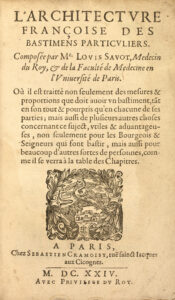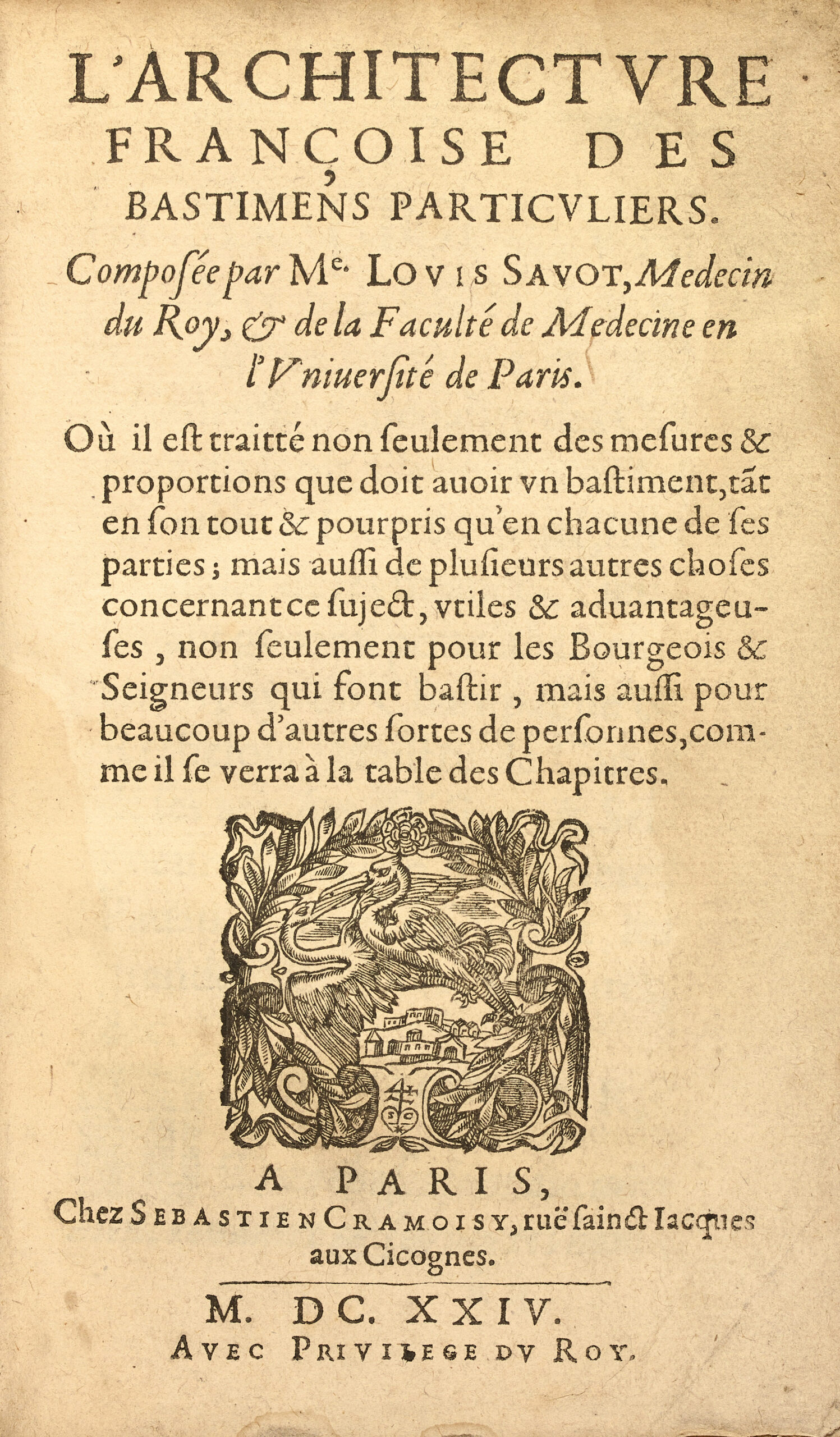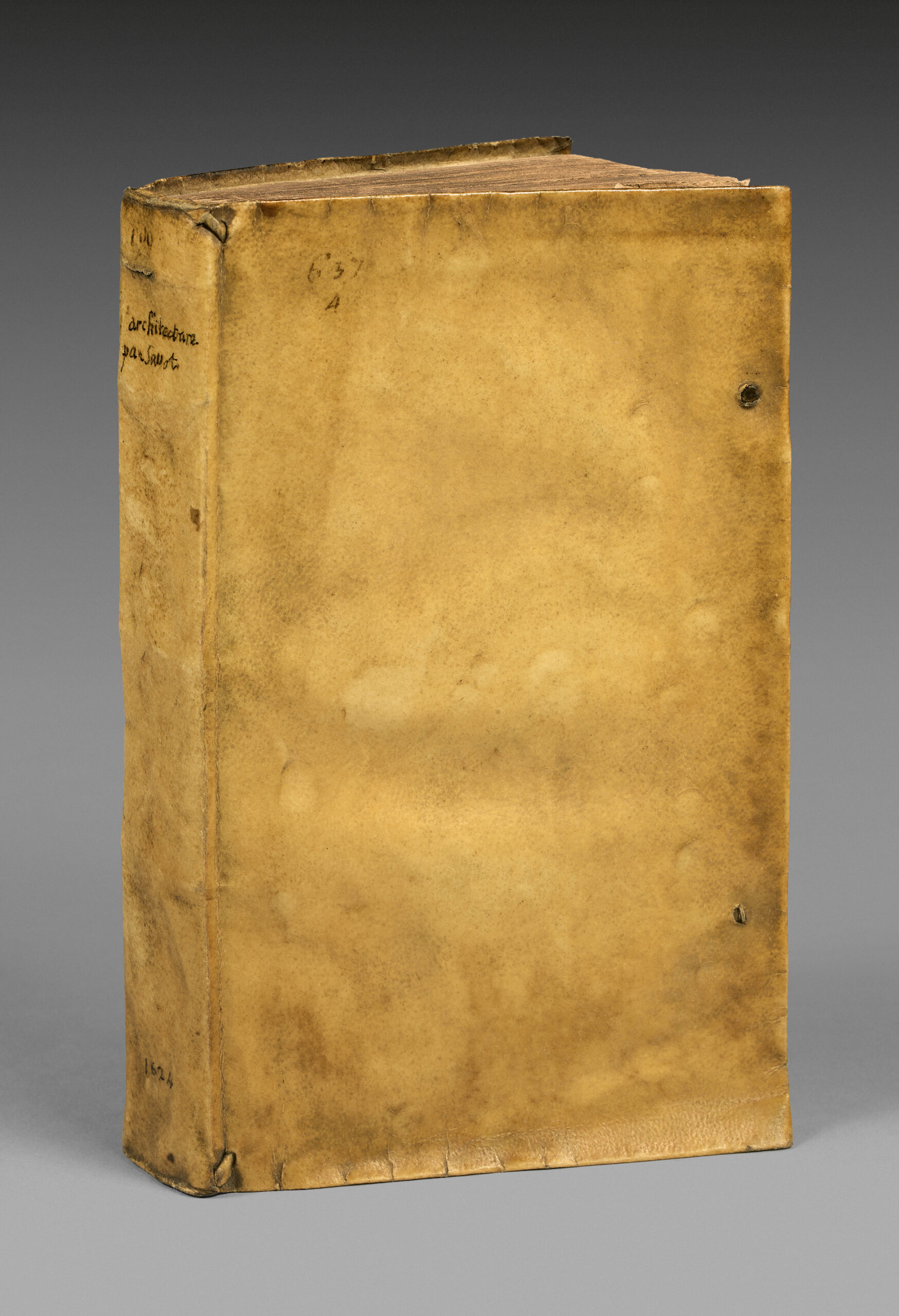Paris, Sébastien Cramoisy, 1624.
8vo with (12) ll. and 328 pages. Full ivory vellum, flat spine, remains of ties. Contemporary binding.
167 x 99 mm.
Extremely rare first edition of “this precious manual, which could be subtitled ‘’Painless Building‘’ (Jean-Pierre Babelon).
L’architecture françoise des bastimens particuliers was published in 1624 in Paris by Sébastien Cramoisy. At the time, the author was described as “the king’s physician”. His life is not well known; he was born in Saulieu around 1579, and died around 1640. He studied medicine in Paris at the age of twenty. In addition to his work as a medical practitioner and theorist, he was also a humanist, reflecting on the best living conditions for his contemporaries. We owe his treatise on architecture to these. As François Blondel noted, it’s natural for doctors to be interested in architecture, and Claude Perrault is another example.
The first evidence we have of his activity is an annotated translation of Galen’s treatise on bloodletting: Le livre de Galien, de l’art de guérir par la saignée, translated from the Greek. Ensemble un Discours dédié à messieurs les médecins de Paris sur les causes pour lesquelles on ne saigne pas encore tant ailleurs qu’à Paris et pourquoy quelques médecins mesme ont détracté de cette pratique de Paris, a 12mo published in Paris by Pierre Mettayer in 1603. We then find him in 1605, qualified as a bachelier in the Faculty of Medicine, already showing his interest in home furnishings by commissioning two colored marble fireplaces for his house on rue Neuve Notre-Dame, in the Cité district. In 1609, a new treatise, dedicated to Godefroy de Pontac, De causis colorum sententia, with observations on Hippocrates, De tetragoni… contra chymicos, Paris, chez Adrien Périer. His Discours sur le subject du colosse du grand roy Henry, posé sur le milieu du Pont-Neuf de Paris… avec un sommaire de la vie de ce grand prince, published in Paris by Nicolas de Montroeil, was republished in the early 19th century by Antoine Laurent Castellan. Savot was also a numismatist, as evidenced by his Discours sur les médailles antiques, a thick 400-page 4to treatise published in Paris in 1627 by Sébastien Cramoisy, of which the Bibliothèque nationale conserves a copy bound with Condé’s coat of arms.
In 1624, he published L’architecture françoise des bastimens particuliers. He had no doubt been gathering thoughts on the subject for some time, and the publication in 1623 of Pierre Le Muet’s treatise Maniere de bastir pour toutes sortes de personnes must have hastened his decision to intervene in the debate. His competitor was an architect, offering a diverse clientele a catalog of standard plans to suit all budgets. Savot’s work is very different in tone. The “private individuals” he addresses are neither princes nor the common people: no palaces, no small houses, but the residences of the nobility and upper middle classes, hotels to be built in the city, in the new districts where space is freely available, or residences “in the fields”.
A physician and therefore a hygienist, Savot advised his clients on how to build the perfect home in terms of comfort and convenience, deciding on the best orientation, lighting and distance from stables and kitchens due to pollution, noise, odors and smoke. He legislates on the place of the staircase, the number of rooms, the layout of bedrooms and closets, the size of windows and the layout of fireplaces.
In his later editions, François Blondel observed that the work was written “to save honest people from the clutches of contractors and workmen”, a remark that follows on from the cruel reproaches levelled at François Mansart in the Mansarade pamphlet (1651). In fact, Savot provides his readers with the best instructions for dealing with contractors from the various trades, giving them detailed figures for the expenses to be expected, the conditions for measuring the work, and even a description of the materials to be used – stone, brick, wood, plaster, terracotta – their dimensions, origin and cost. Never before had construction been approached in such a practical way, allowing private individuals to personally supervise their building sites.
It’s easy to understand the success of this invaluable manual, which could be subtitled “Le bâtiment sans douleur” (“Building without pain”). Dedicated to the short-lived superintendent of finance Charles de La Vieuville, it was republished, still without engravings, in 1642, and its success extended well beyond the death of its author, since the architect François Blondel, first director of the Académie d’architecture and an illustrious teacher, saw fit to republish it, proof that it was still useful to his clientele. This first republication appeared in 1673 with François Clousier l’aîné, enriched with figures and notes by Blondel (423 pages), and the second in 1685, augmented with new figures contemporary with his architecture course, clearly illustrate the evolution of society’s reflections on the house and its use since the previous generation.” Jean-Pierre Babelon (Institut de France, Paris 2006).
A precious copy preserved in its contemporary ivory vellum binding.



